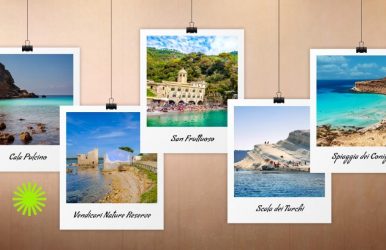Unlocking The Secrets: Key Ingredients In Italian Cuisine
BY Ankita Feb 21, 2024
Italian cuisine is a hit in the United States; if you don't believe me, take a walk in Bensonhurst and Bay Ridge in Brooklyn, where you'll get more than a taste of the food, but experience the culture as well. Short of trekking through Italy, there are limited ways in which you can experience the magic of the country. One of those ways is through food. You could trawl through all the Italian restaurants and bistros in your neighborhood, or you could just cook some traditional dishes at home. Read on to learn more about Italian cuisine and some of its key ingredients. Popular Italian Dishes There are foods we have embraced and enjoy so much that we forget they originated from Italy. Here are a few examples of some that have become staple dishes. Pizza Pizza is the most famous Italian food, and it has won the world over; I mean, who doesn't love pizza? You can top your pizza with almost anything, but did you know the earliest pizzas were topped with garlic, lard, and salt? Lasagne Lasagne was initially reserved for special occasions during the Middle Ages; nowadays, we enjoy it as a filling meal with a salad or bread. Tiramisu This iconic Italian dessert means "pick me up" or “cheer me up” in Italian, understandably so. The sweet, fluffy, and light dessert that melts in your mouth will definitely lift your spirits. Cooking The Italian Way At the core of Italian cooking is the emphasis on fresh ingredients; most people buy packaged pasta and use canned tomatoes and condiments. Authentic Italian cooking requires fresh ingredients. While some may see Italian dishes as unhealthy because of their high-carb content, the opposite is true. Let's look at the key ingredients used in Italian cooking Pasta There are more than 350 different shapes of pasta; it also comes in various forms, such as dried, fresh, or dumpling pasta. Each kind is suitable for a different dish, such as Penne for Penne Arrabbiata and lasagne sheets for lasagne. It's easy to see why pasta is a multi-million dollar business in Italy. It's versatile and works with meat, vegetables, and even dessert (vermicelli) dishes. It doesn't need a lot of flavoring either; you just need to add a sauce and some cheese, and you are good to go. Pasta is an excellent source of carbohydrates; it's filling and affordable. If you are watching calories, you may opt for the whole-grain variety. Read Also: Exploring The Allure Of Holiday Getaways In Italy Olive Oil Olive trees are grown across Italy, with some of the best coming from Liguria and Tuscany, so it's no surprise that most Italian dishes call for olive oil. The oil is high in monounsaturated fatty acids, which can help lower your cholesterol levels. It also has excellent antioxidant and anti-inflammatory properties. So, what's the difference between virgin olive oil and extra virgin oil? Simply put, extra virgin oil goes through less processing and thus retains more of its natural antioxidants and vitamins. Virgin olive oil also has a higher free acidity rating (0.8 - 2.0) than extra virgin olive oil ( less than 0.8). For authentic Italian olive oils, check out Dolceterra (visit website). Tomatoes Even though tomatoes are not native to Italy, they are firmly at the center of Italian cooking. There are different uses for different kinds of tomatoes; cherry tomatoes are great for salads or stuffing, like in a Caprese stuffed mozzarella, while plum tomatoes make the best sauces. Using tomatoes is not just one of the easiest ways to flavor food; think of spaghetti bolognese. Tomatoes are also known to ease inflammation and boost your immune system; they taste great, too. It's also an excellent preservative. Tuscan cooking is based on limiting food wastage; in historical times, leftover meats were cooked with tomato to preserve them and give them more flavor. And, what is a pizza without a tomato sauce base? We can see why tomatoes have become so central to Italian cuisine. Basil Basil is a flavorful African and Asian herb that comes in different varieties. It is very popular in pasta sauces; hence, we associate it with Italian cooking. Most tomato sauce recipes call for fresh basil, and it is also used in pesto. Basil oil can be used as part of a bread dip or to flavor vegetables. Basil vinegar is excellent in salads as well. Fresh basil is the most flavorful, so it's better to use it. Basil works well with other herbs, such as rosemary, oregano, and dill; this is also applicable in planting. You can plant basil alongside dill, cilantro, and chives. The great thing about basil is that it's easy to grow and doesn't need much space. Cheese Due to new research and eating trends, dairy products have been getting a bad reputation recently. Despite this, we still love our cheese, and what would a pizza be without mozzarella cheese? Cheese is an integral part of Italian cooking, with several famous cheeses made in the country. Mascarpone for tiramisu, fontina for a fondue and Parmigiano Reggiano for pasta. Cheese adds flavor to the pasta's starchiness and helps bind ingredients together in sauces. It also contributes to the texture of the sauce. You can also serve cheese on its own on a cheese board paired with great wine; while this is not authentically Italian, it does show how versatile cheese is. Most cheeses are an excellent source of calcium, and they also have protein. Wine Wine is fundamental to Italian cuisine and not just for drinking; think of Cioppino, which needs it as a key ingredient. Here are a few tips when pairing wine: Chianti is very compatible with tomato-based sauces. So, it goes well with pizza and creamy tomato pasta. A cabernet-sauvignon elevates the flavor of aged cheeses. Pair a provincial dish with a regional wine. Lastly Italian cuisine is not complicated, and we love it; you can make the most straightforward meal, which will be delicious. Most meals are made with fresh ingredients, which makes them healthier and tastier. You can integrate Italian meals into most eating plans without feeling guilty. Read Also: Common Pitfalls Of Destination Wedding In Italy And How To Avoid Them How Much Time To Spend In Italy Best Places To Visit In Italy














Reading your blog post about how much time to spend in Italy has truly ignited my wanderlust! Italy’s rich history, diverse culture, and breathtaking landscapes make it a dream destination for many travelers. Your insights into finding the right balance between exploring iconic cities like Rome, Venice, and Florence, and immersing oneself in the charming countryside and coastal gems are invaluable. It’s fascinating how Italy’s regions offer such distinct experiences, from indulging in culinary delights to soaking in centuries of art and architecture.
Your tips on crafting an itinerary that allows for both must-see sights and serendipitous discoveries are spot-on. Whether it’s savoring an authentic pizza in Naples or gazing at the stunning Amalfi Coast, every moment spent in Italy seems to be a magical journey. Thank you for helping us navigate the complexity of planning a visit to this enchanting country.